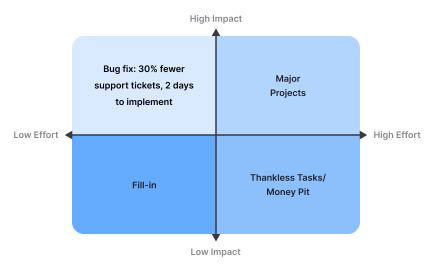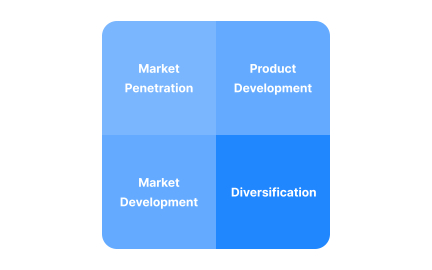Product Process Matrix
The product process matrix maps how different product types align with production processes to help teams choose the right development model.
What is Product Process Matrix?
Your operations struggle to match production methods with product characteristics because you apply the same manufacturing approach to everything, leading to excessive costs for simple products and quality issues for complex ones when process complexity doesn't align with product needs.
Most companies choose production processes based on tradition or available equipment without systematic analysis, missing the strategic framework of the Product Process Matrix that matches product variety and volume characteristics with appropriate process types for optimal efficiency and quality.
The Product Process Matrix is a strategic framework that maps product characteristics (volume and variety) against process characteristics (flexibility and flow) to identify optimal production approaches, from job shops for custom work to continuous flow for commodities.
Organizations using the Product Process Matrix effectively reduce production costs by 40%, improve quality by 55%, and achieve significantly better operational efficiency because they align process complexity with product requirements rather than forcing mismatched approaches.
Think about how Toyota uses different production lines for different vehicle types, or how Amazon fulfillment centers organize differently for books versus custom products, matching process sophistication to product needs.
Why Product Process Matrix Matters for Operations Strategy
Your production efficiency suffers because high-variety products get forced through rigid mass production lines while high-volume products inefficiently move through job shop environments, creating waste and quality issues when process doesn't match product characteristics.
The cost of process-product mismatch compounds through every inefficient operation and quality problem. You overspend on simple products, underdeliver on complex ones, frustrate workers with inappropriate systems, and lose competitive position when competitors better match process to product.
What effective Product Process Matrix application delivers:
Better cost efficiency through appropriate process selection because simple products use simple processes while complex products get necessary flexibility rather than one-size-fits-all operations.
When organizations apply the matrix properly, production costs align with product value rather than expensive processes for commodity products or inadequate processes for premium ones.
Enhanced quality and customer satisfaction through processes that match product requirements rather than forcing products through inappropriate production methods.
Improved operational flexibility and efficiency because the matrix reveals where to standardize versus customize rather than guessing at process design.
Stronger competitive positioning as proper process-product alignment enables cost leadership for commodities and differentiation for custom products simultaneously.
Reduced operational complexity through clear framework for deciding which products belong in which production environments rather than scattered decision-making.
Advanced Product Process Matrix Applications
Once you've mastered basic matrix application, implement sophisticated operational strategies.
Dynamic Matrix Positioning: Move products between processes as volumes change rather than static assignment, optimizing alignment as products mature through lifecycle.
Diagonal Strategy Development: Find innovative positions between traditional matrix corners rather than accepting standard trade-offs, creating unique operational capabilities.
Multi-Matrix Portfolio Management: Apply different matrices for different business units rather than forcing single approach, recognizing diverse operational needs.
Technology-Enabled Matrix Evolution: Use automation and AI to expand feasible matrix positions rather than accepting traditional constraints, redefining possible process-product combinations.
Step 1: Analyze Product Characteristics (Week 1)
Map your products by volume and variety to understand portfolio positioning rather than treating all products equally, revealing natural groupings for process alignment.
This creates matrix foundation based on actual product mix rather than assumptions about what you produce and how it should be made.
Step 2: Assess Current Process Capabilities (Week 1-2)
Evaluate existing processes for flexibility, efficiency, and flow characteristics rather than accepting current state, identifying mismatches between process and product needs.
Focus assessment on costly misalignments rather than minor inefficiencies, prioritizing where process-product mismatch creates biggest problems.
Step 3: Identify Optimal Process Positions (Week 2-3)
Use matrix framework to determine ideal process type for each product group rather than forcing everything through existing processes, planning strategic alignment.
Balance ideal positioning with practical constraints to ensure recommendations are achievable rather than theoretical perfection without implementation path.
Step 4: Design Migration Strategy (Week 3-4)
Create plan to move products to appropriate processes or adjust processes for products rather than immediate wholesale changes, managing transition risks.
Step 5: Implement and Monitor Alignment (Month 2+)
Execute changes while tracking efficiency and quality improvements rather than assuming benefits, adjusting based on actual results versus theoretical predictions.
This ensures Product Process Matrix drives real operational improvement rather than academic exercise without business impact.
If matrix application doesn't improve operations, examine whether you're truly aligning process with product rather than minor adjustments without fundamental match.
The Problem: Organizations stuck in traditional matrix positions, unable to see innovative diagonal strategies that could create competitive advantage.
The Fix: Challenge conventional process-product assumptions rather than accepting standard positions, exploring how technology enables new combinations.
The Problem: Resistance to moving products to appropriate processes due to organizational inertia and departmental boundaries.
The Fix: Build business case showing cost and quality benefits rather than theoretical arguments, demonstrating value through pilot programs.
The Problem: Oversimplifying complex product portfolios into few matrix positions, missing nuanced process needs of different product variations.
The Fix: Create sub-matrices for product families rather than forcing all products into single framework, maintaining useful detail while avoiding overwhelming complexity.
Create Product Process Matrix approaches that optimize operations strategically rather than accepting misaligned processes as unchangeable constraints.
Recommended resources
Courses

Product Discovery

Product Analytics






